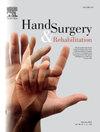Proximal phalanx fracture treated by a Lucerne cast with early active motion: a retrospective study of 71 fractures
IF 1
4区 医学
Q4 ORTHOPEDICS
引用次数: 0
Abstract
This retrospective study presents the results obtained using an early active motion protocol for all types of closed proximal phalanx fractures, with or without initial rotational deformity or extension lag, treated with a Lucerne cast. Out of the 71 patients included in the study, 54 responded (71 fractures; response rate: 76%). Assessment was conducted using the total active motion score, (TAM) grip strength, and key pinch. A series of questionnaires were also administered, including a visual analogic scale (VAS) for pain and satisfaction, the Michigan Hand Outcomes Questionnaire (MHQ), the patient-rated wrist/hand evaluation and the SF-36 score. The minimum follow-up period was six months. The mean TAM score was 90.9% compared to the uninjured side. The VAS satisfaction score was 86.2%, the VAS pain score was 1.0 points and the MHQ score was 83.8 points versus 92.9 points for the uninjured side. Fourteen percent of patients experienced complications. In conclusion, conservative treatment of extra- and intra-articular proximal phalanx fracture using an early active motion protocol in a Lucerne cast is favourable, providing excellent results in terms of mobility, force, function, and patient-related outcomes.
Level of evidence 4
Retrospective study (case series).
卢塞恩石膏治疗近端指骨骨折,早期活动。
本回顾性研究介绍了采用早期主动运动方案治疗所有类型的闭合性近端指骨骨折的结果,不论有无初始旋转畸形或伸展滞后,均采用Lucerne石膏进行治疗。在纳入研究的71例患者中,54例有反应(71例骨折;回应率:76%)。评估采用总主动运动评分(TAM)握力和键捏。研究人员还进行了一系列问卷调查,包括疼痛和满意度视觉模拟量表(VAS)、密歇根手部结果问卷(MHQ)、患者评定的腕/手评估和SF-36评分。最短随访期为6个月。与未损伤侧相比,平均TAM评分为90.9%。VAS满意度为86.2%,VAS疼痛评分为1.0分,MHQ评分为83.8分,未损伤侧评分为92.9分。14%的患者出现了并发症。总之,在Lucerne石膏中使用早期主动运动方案保守治疗关节外和关节内近端指骨骨折是有利的,在活动能力、力量、功能和患者相关结果方面提供了良好的效果。证据级别4:回顾性研究(病例系列)。
本文章由计算机程序翻译,如有差异,请以英文原文为准。
求助全文
约1分钟内获得全文
求助全文
来源期刊

Hand Surgery & Rehabilitation
Medicine-Surgery
CiteScore
1.70
自引率
27.30%
发文量
0
审稿时长
49 days
期刊介绍:
As the official publication of the French, Belgian and Swiss Societies for Surgery of the Hand, as well as of the French Society of Rehabilitation of the Hand & Upper Limb, ''Hand Surgery and Rehabilitation'' - formerly named "Chirurgie de la Main" - publishes original articles, literature reviews, technical notes, and clinical cases. It is indexed in the main international databases (including Medline). Initially a platform for French-speaking hand surgeons, the journal will now publish its articles in English to disseminate its author''s scientific findings more widely. The journal also includes a biannual supplement in French, the monograph of the French Society for Surgery of the Hand, where comprehensive reviews in the fields of hand, peripheral nerve and upper limb surgery are presented.
Organe officiel de la Société française de chirurgie de la main, de la Société française de Rééducation de la main (SFRM-GEMMSOR), de la Société suisse de chirurgie de la main et du Belgian Hand Group, indexée dans les grandes bases de données internationales (Medline, Embase, Pascal, Scopus), Hand Surgery and Rehabilitation - anciennement titrée Chirurgie de la main - publie des articles originaux, des revues de la littérature, des notes techniques, des cas clinique. Initialement plateforme d''expression francophone de la spécialité, la revue s''oriente désormais vers l''anglais pour devenir une référence scientifique et de formation de la spécialité en France et en Europe. Avec 6 publications en anglais par an, la revue comprend également un supplément biannuel, la monographie du GEM, où sont présentées en français, des mises au point complètes dans les domaines de la chirurgie de la main, des nerfs périphériques et du membre supérieur.
 求助内容:
求助内容: 应助结果提醒方式:
应助结果提醒方式:


